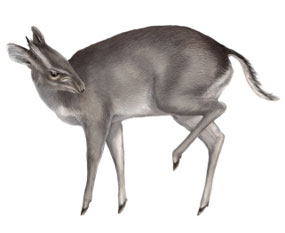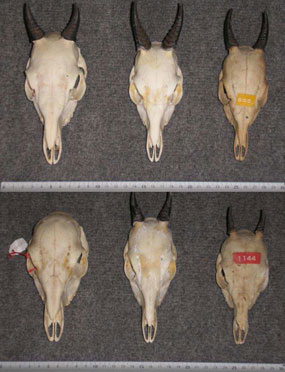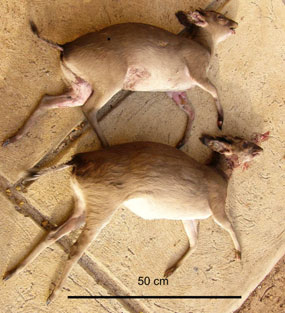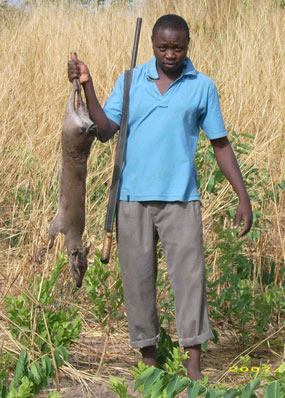New African Antelope Discovered
Posted by: Loren Coleman on October 10th, 2011

The new species: Philantomba walteri or Walter’s duiker. Illustration: ©Yann Le Bris
In 1821, the French naturalist and zoologist George Cuvier made what has been called his “Rash Dictum”: he remarked that it was unlikely that any large animal remained undiscovered. Many such discoveries have been made since the time of Cuvier’s statement, needless to say.

Yet another new mammal has been discovered, a new African Antelope.

From the press release comes information on this new species:
Erik Verheyen, Gontran Sonet and Zoltán T. Nagy, three scientists from the Museum [of the Royal Belgian Institute of Natural Sciences], have, with the team of international researchers they are members of, discovered a new species of antelope that occurs in Togo, Benin, and Nigeria.
It is a very small antelope, measuring no more than around 40 cm at the shoulder and weighing four to six kilograms. It belongs to the duiker subfamily of antelopes. The Afrikaans name, ‘duiker’, meaning ‘diver’, comes from the habit these timid animals have of diving into the vegetation at the slightest sign of danger.
The new species has been named Philantomba walteri, or ‘Walter’s duiker’ in homage to Erik Verheyen’s father, Professor Walter Verheyen (°1932-†2005). As professor at Antwerp University, he was the first scientist to collect a specimen of this species.
Until now only two species of antelope had been recognised within the genus Philantomba. Both are widely distributed in West and Central Africa where they are hunted extensively. Their horns are used in traditional medicine and their meat is much in demand at bushmeat markets. It was known that one of these species, namely Maxwell’s duiker (Philantomba maxwelli), showed a geographical variation between different populations. Morphological studies and DNA tests have now shown that some of these populations form a distinct species.
The scientists were able to demonstrate this on the basis of specimens bought from local hunters or found at markets. Use was also made of specimens from museum collections….

Local hunters knew of the animal for they were killed for meat and the market.
The full citation for the source paper is:
Colyn M., Hulselmans J., Sonet G., Oudé P., de Winter J., Nata A., Nagy Z., Verheyen E. (2010). Discovery of a new duiker species (Bovidae: Cephalophinae) from the Dahomey Gap, West Africa. Zootaxa 2637: 1–30
About Loren Coleman
Loren Coleman is one of the world’s leading cryptozoologists, some say “the” leading living cryptozoologist. Certainly, he is acknowledged as the current living American researcher and writer who has most popularized cryptozoology in the late 20th and early 21st centuries.
Starting his fieldwork and investigations in 1960, after traveling and trekking extensively in pursuit of cryptozoological mysteries, Coleman began writing to share his experiences in 1969. An honorary member of Ivan T. Sanderson’s Society for the Investigation of the Unexplained in the 1970s, Coleman has been bestowed with similar honorary memberships of the North Idaho College Cryptozoology Club in 1983, and in subsequent years, that of the British Columbia Scientific Cryptozoology Club, CryptoSafari International, and other international organizations. He was also a Life Member and Benefactor of the International Society of Cryptozoology (now-defunct).
Loren Coleman’s daily blog, as a member of the Cryptomundo Team, served as an ongoing avenue of communication for the ever-growing body of cryptozoo news from 2005 through 2013. He returned as an infrequent contributor beginning Halloween week of 2015.
Coleman is the founder in 2003, and current director of the International Cryptozoology Museum in Portland, Maine.










Just goes to show that for everyone of us who would love to find a new unclassified animal to study and document, there is another who wants to find a new unclassified animal to stuff into a tortilla. Sad way to find these cute little guys, but it’s usually the locals who say “Yah, I’ve seen one of those just the other day. It tasted like chicken.” A find is a find, I guess.
Too all future Bigfoot and or other cryptid hunters out there: look at the last pic on this thread showing the hunter and the dead Walter’s Duiker: that’s how you find a new species. Not by prints or hair, but a body, living or dead.
Do thou likewise.
@choppedlow
Kind of a douchy sounding comment. I’m new here, but still, to say they “want to find a new species and stuff it in a tortilla” is moronic. Its not like the people here hunting with a WWII era rifle they had to trade home made goods to get, is going to plug into Google to check and make sure hes hunting and eating something that us fat slobs checking our websites from McDonalds have heard of it.
They’ve probably been eating it for a hundred years, just because we recently took the time to notice what less fortunate countries are doing to survive, is our fault, not theirs.
yeah but how long will this “new species” be around if like our friend in the pic shoots them all!
Its not new. It didnt fall out of the sky the day this report got posted, and people started shooting it.
How much longer will there still be deer running around when the guys at my work go hunting and kill em every year? How will there still be fish in the ocean if we keep eating them? How do we still have cows after a billion patties served?
Hunting and eating animals is what these people have to do to survive. There is no cow farm there genetically manipulating cows to make good beef for dinner.
Go to Africa and open a Wendys if you’re worried about them eating an antelope you haven’t seen before.
@Shmargin, nothing says “I’m better than you (and everyone else) like using the phrase “douchy”. When you have gone to the tip of the Sea of Cortez (El Gulfo to be exact) with a group from UofA to research a rare desert horny toad only found near the estuaries, and you find a local family who finds them all the time and have grown to find them quiet tasty, you will know what I mean when I say that a local will find something we think is rare, and put it in a “tortilla”. I meant it literally because it happens all the time. We see these animals a lot different than a local who is hungry.
Also, there will still be lots of deer running around even after everyone at your work shoots them all. You see, the Fish and Game dept. spends millions on keeping tabs on the deer population. They only allow a certain number of tags per season, and those tags are won by a lottery. Then you figure only half of those tags get filled. If they have low populations, they will even stop the hunt all together. If people didn’t hunt there would be deer all over the place, starving and sick. Also, thank the fishermen who are the only reason the salmon still run in California. They would have been netted for food and decimated a long time ago if it wasn’t for the efforts of the F and G. Most hunters report those who poach game, liter, leave fires going…. Us hunters enjoy the outdoors and take trashing it personally. If you have a beef with our lands being trashed, feel free to venture into the AZ deserts along the border and see the two thousand tons of trash that the illegals leave behind (average 8 lbs per person). Those are the most fragile ecosystems we have in this country, and no one will even bother to do anything about it. Start there.
Um. Chopped, you completely missread what I typed. I was agreeing with you to an extent, when I was talking to the other guy, I was saying they have to shoot them to survive. I was making a point that there are all those things despite the fact we do them.
I felt you both made it sound like it was such a bad thing that they eat them because you think its interesting. I say, people are doing what they have to do to survive.
Anyways, at least in my opinion, this comment thread has skewed off topic and is no longer relevant. I hope those antelope are delicious.
In your FACE Cuvier!That goes double for all the unbelievers out there!